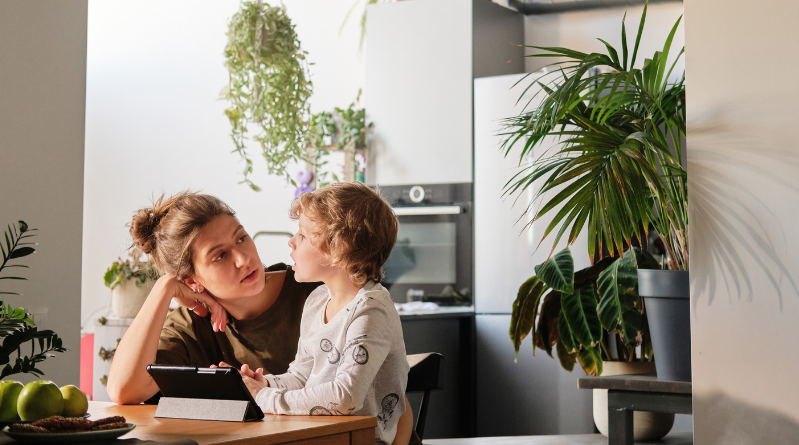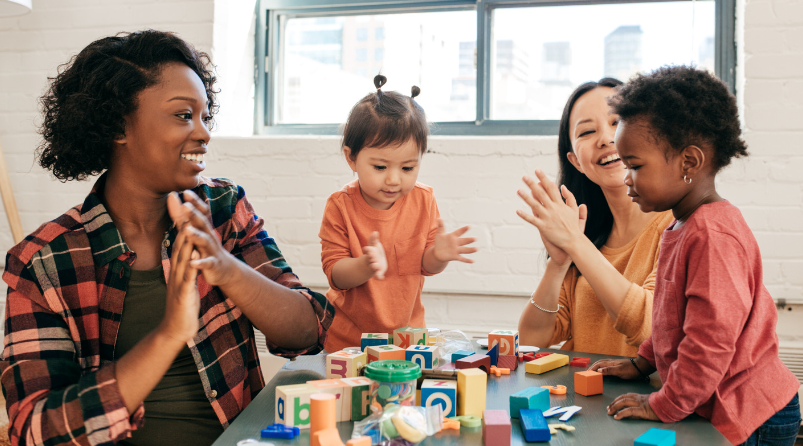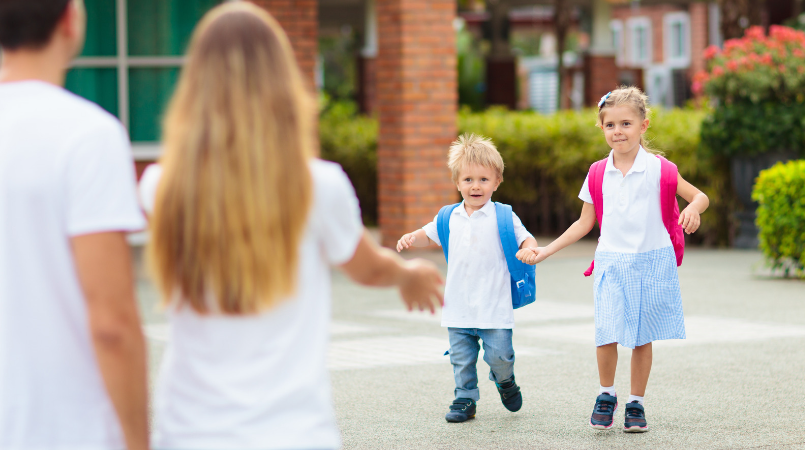Heading into the first day of daycare? Oh, it’s a big moment for everyone! Kids might feel jittery, worrying about what’s in store, and let’s not forget the parents! Yeah, it’s tough – that mix of guilt about leaving your little one and wondering, “Will they be okay?”
Easing into it can make a world of difference. It’s all about making both kiddos and parents feel more at ease. Finding ways to lessen those jitters and build up a sense of familiarity can turn the whole experience around. It’s like laying down a comfy, emotional groundwork for this new adventure.
Preparing Before the Daycare Start Date

Alright, let’s get you set! Prepping before daycare starts isn’t just smart; it’s a game-changer. Here are some handy tips to smooth out those first-day jitters for you and your little one.
Visits and Orientation
Visiting the daycare with your child beforehand is crucial. It helps your child acclimate to the new environment, meet their caregivers, and reduce first-day anxieties. This familiarization can significantly ease the transition, making the first day smoother for both child and parent.
Attending orientation sessions at the daycare is key. These sessions offer a comprehensive overview of the daily routine, safety protocols, and educational activities. They provide an excellent opportunity for parents to ask questions and address any concerns ahead of time.
Talking to Your Child About Daycare
Explain to your child that daycare is a special place where they’ll play, learn, and make new friends. Describe the activities they’ll participate in, like art projects, story time, and outdoor play, to build excitement and set positive expectations.
Listen attentively to your child’s worries about daycare. Validate their feelings, reassure them that it’s okay to feel nervous, and discuss how their teachers are there to help them feel safe and happy. Sharing a comforting object may also ease their apprehension.
Adjusting Your Child’s Routine
Begin synchronizing your child’s sleeping and eating patterns with the daycare’s schedule prior to starting. Gradually shifting nap times and meals help their body clock align with the new routine, reducing stress and improving adaptability.
Consistent routines are pivotal in children’s lives, providing security and predictability. Establishing a solid routine aids smoother transitions, particularly when adjusting to new environments like daycare, by setting clear expectations and reducing anxiety.
Building Familiarity and Comfort

Let’s talk about making daycare feel like a second home. Building comfort and familiarity for your child starts with simple, engaging steps that turn a new space into a friendly, welcoming one.
Introduce the Concept of Separation
Start with short, scheduled times apart to help your child get used to being away from you. These practice separations can reduce anxiety and build resilience, easing the transition to daycare.
Engaging in role-play can dramatically help children adjust to daycare. Pretend together that you’re at daycare; go through activities like circle, snack, and nap time. This play acts as a gentle introduction to their new daily routine.
Choosing a Comfort Object
Letting your child pick a small, comforting item to accompany them to daycare is beneficial. Facilitating this choice empowers them, offering emotional support through familiarity amid new surroundings. Ensure the object is daycare-appropriate, creating a tangible connection to home while they adapt to their new environment.
Engage with Stories and Books
Introducing books that tackle themes of daycare and separation can significantly aid in preparing your child for the change. These stories validate their feelings and model positive coping strategies, making the transition smoother and less intimidating.
Viewing child-friendly programs or shows that explore themes of change, particularly around daycare or separation, can also be beneficial. They provide visual cues and scenarios that a child can understand and relate to, helping them feel less alone in their experience.
The Night Before the First Day

Get ready, set the alarm, and lay out your outfit. A restful sleep awaits before the big first day. The excitement in the air — success starts with tonight’s preparation!
Preparing Together
Gather the essentials for their daycare bag—with your little one’s help. Include a beloved comfort item for ease, plus the practicals: diapers, wipes, and a change of clothes for just-in-case moments.
Involve your little ones in packing their food for the day. Choose healthy options together for lunches and snacks. Engage them in preparing the food where possible, instilling independence and smart food choices.
Establish a Calming Bedtime Routine
For a serene night, dim the lights and ease into bedtime with quiet activities. Maintain a consistent schedule to reinforce natural sleep patterns, ensuring your child wakes refreshed and ready for the day.
Foster tranquility by ending the night with a bedtime story or a gentle conversation. This can soothe their thoughts, sparking imagination or reassuring them about the upcoming day, thus promoting restful sleep.
The Morning of the First Day

Wake up with enthusiasm! Today marks a new beginning. Fuel up with a hearty breakfast, pack those essentials, and step out with confidence. A brilliant first impression awaits.
Maintaining a Positive and Calm Atmosphere
Start mornings with tranquility by waking up a bit earlier than necessary. This extra time allows for a leisurely pace, reducing stress for you and your child. A calm routine sets a positive tone, helping your child face the day with confidence.
Remember that your emotions significantly impact your child. Strive to manage stress and react with patience. Even during challenging moments, demonstrating calmness and positivity teaches your child how to handle their emotions and approach situations with a balanced outlook.
A Reassuring Goodbye
When it’s time to part, keep your goodbye brief but full of warmth. A quick hug, a kiss on the forehead, and a reassuring smile are all it takes. Your composed demeanor will convey security, making separating your child easier.
Always remind your child that you will return after their day is done. This reiteration of your comeback helps build trust and eases any anxiety they might feel about the separation. It’s a simple assurance that fosters confidence and stability in their routine.
During the Day

Stay focused, seize every opportunity to learn, and don’t shy away from asking questions. Remember, making mistakes is part of the journey. Embrace it all to grow and thrive.
Staying Connected
To stay connected with your child’s day, inquire with the child care center staff if they can provide updates or photographs during the initial adjustment period. Regular insights into their activities can reassure you of their well-being and ease the transition for both of you.
Trusting the Caregivers
Remember that daycare professionals have specialized training to support children through separation anxieties. Trust in their expertise and dedication to attend to your child’s needs, enabling a smoother transition and ensuring a nurturing environment for your child’s development.
Reunion and Aftercare

Reunions bring joy, and it’s crucial we chat about the aftercare needed to nurture these rekindled connections. Let’s ensure these bonds flourish well beyond our initial joy.
Pick-up Time
Upon pickup, warmly welcome your child with a hug or a smile and engage them in a gentle conversation about their day. Show genuine interest in their activities, friends, and feelings, fostering a safe space for them to open up and share their experiences confidently.
Embrace patience as your child navigates through their emotions and recollections, whether they’re brimming with excitement or navigating uncertainties. Listen attentively, validate their feelings, and offer comfort or encouragement. This patience underscores your support and helps them process their day, strengthening your bond.
Establishing a Post-Daycare Routine
Create a regular post-daycare routine with a designated discussion and relaxation time. This structured period allows your child to decompress from the day’s activities and ensures they have your undivided attention to process their experiences.
Adhering to a consistent after-daycare routine not only smooths the day-to-day transition but also offers your child a reliable sense of predictability. This regularity is comforting, fostering security and reinforcing their understanding that they have a safe, stable environment to return to each day.
Overcoming Common Challenges
Handling Tears and Tantrums
For handling tears and tantrums, begin with calm, reassuring routines for morning separations, and empathetic listening at day’s end to navigate meltdowns. If these issues persist, consider seeking advice from a child psychologist to develop tailored strategies for your child.
Maintaining Communication with Daycare Providers
Maintaining open, regular communication with your child’s daycare providers is key. This ensures you’re informed about your child’s day-to-day experiences, enabling you and the caregivers to support your child’s needs collaboratively and ease their transition between home and daycare environments.
Final Thoughts
Ensuring a smoother transition into daycare center hinges on consistent routines, open communication with caregivers, and addressing emotional transitions with patience. Time and understanding from parents and children are key to adjusting to new routines and relationships.
If challenges persist, seeking support is a positive step forward. At Kemit Academy, we’re here to offer guidance and resources tailored to your family’s needs. Don’t hesitate to reach out for personalized assistance as you navigate this transition.

